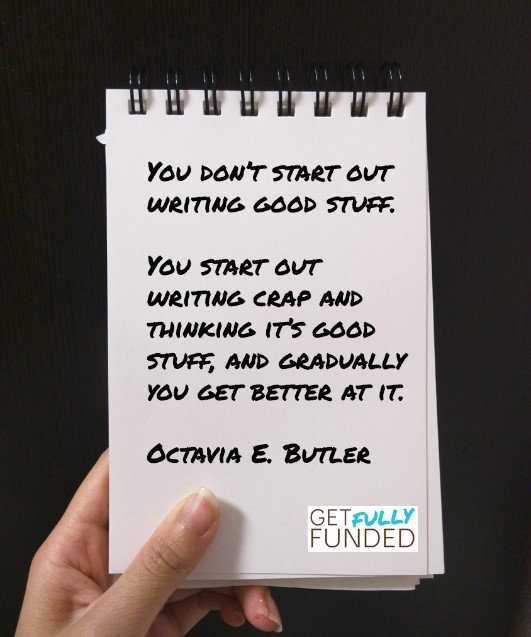Fundraising is based on relationships. Relationships are built through communication and trust.
That means if you’re not communicating regularly with your donors, you will lose them, plain and simple.
Since most of your donor communications will be in print, writing for fundraising is key to your success.
 Think about it: Donors keep up with your organization by reading your emails, newsletters, blog, and social media posts. Annual reports and mid-year updates give them even more insight.
Think about it: Donors keep up with your organization by reading your emails, newsletters, blog, and social media posts. Annual reports and mid-year updates give them even more insight.
It would be great if you could always be face to face with donors so you could personally share stories and they could feel all of the passion and energy you pour into your organization.
But since you don’t have that kind of time, you must rely on the written word to educate and inspire.
When done well, your writing can communicate both passion and purpose to your donors, volunteers, and a whole community of potential allies, setting their hearts on fire for the work your nonprofit does.
So, how do you build your skill in writing for fundraising? How do you overcome writer’s block and stay motivated, especially if you don’t consider yourself a writer?
3 main kinds of writing for fundraising
Not all writing that you need to do for raising money is the same.
Different styles of writing are required for different fundraising efforts and forums.
The easy-breezy conversational quality of an upbeat announcement on your website is different from the very specific, information-heavy language of a grant.
It’s important that you decide what kind of writing you need before you begin the piece you need written so you can get the tone right from the start.
Some of these types of writing will require information and input from your whole organization, while others you can handle on your own. Stories may require details from front-line staff or from those you serve, so be prepared to get input from others before you write.
Here are the 3 main kinds of writing you will need to be able to write:
What to do if you’re not a great writer
Not everyone loves to write and not everyone is good at it.
Maybe it’s hard for you to translate your passion into words on the page. Maybe you don’t like to sit still for that long. Or maybe you’ve been told somewhere along the way that you’re not a good writer and you believed it.
What should you do if you’re one of those people? There are three possibilities.
 Learn – Writing for fundraising is a learnable skill. You might think that only certain kinds of people are “writers,” but if you have passion and drive, you can pick up a lot of tips and techniques to refine your skill. You’ll find tons of articles and blog posts online about writing great fundraising appeals. Likewise, there are plenty of online resources devoted to nonprofit storytelling. Yes, learning is great and I encourage you to pick a few people you like and follow their guidance. Then write. The best thing you can do is to simple write. Every day. The more you do it, the better you’ll get at it. Practice makes perfect, you know.
Learn – Writing for fundraising is a learnable skill. You might think that only certain kinds of people are “writers,” but if you have passion and drive, you can pick up a lot of tips and techniques to refine your skill. You’ll find tons of articles and blog posts online about writing great fundraising appeals. Likewise, there are plenty of online resources devoted to nonprofit storytelling. Yes, learning is great and I encourage you to pick a few people you like and follow their guidance. Then write. The best thing you can do is to simple write. Every day. The more you do it, the better you’ll get at it. Practice makes perfect, you know.
- Outsource – There are plenty of freelance writers out there who would love to write for you. Depending on your budget, you can farm out some, most, or all of your writing to them. Some freelance writers specialize in writing for fundraising, and they already understand the intricacies of donor communications. Experienced writers already have tried and tested ideas and techniques, but if you’re struggling with your budget, don’t discount writers who are trying to break into the business as they may be more affordable. Younger and newly graduated writers have grown up surrounded by social media and may be able to create online communications in ways you’ve never thought of!
- Delegate – You may have staff or volunteers who are good writers and can take over some of your writing tasks. Ask around and find out if you have an English or journalism major hanging around somewhere (because you just might)! If you find someone who loves to write, you can brainstorm ideas and then hand off the actual writing of the letter or the blog post. A staff member or a volunteer already shares your passion and has insider knowledge of your organization and its impact. Depending on the size of your organization, you may eventually even consider hiring a staff member whose time is entirely devoted to communications.
4 steps to writing anything
Before you sit down to write, here are some basic steps to take you from blank screen to finished piece.
1. Start by identifying the call to action – Figure out what you want the reader of your piece to do, then gear the entire article or letter to that goal. Make the call to action urgent; they need to do this now. Use powerful and passionate action verbs to make your case like transform, change, and donate. Make sure your writing is not tentative. Don’t say, “Many animals could be helped if people like you would be willing to give.” Say “You can help animals today.” Better yet, clearly tell people exactly what you need. Say “You can give a dog a bed and food for a week at our rescue by donating fifteen dollars today.”
2. Brain dump your ideas then organize them – Don’t try to fully form ideas or get too worried about whether you’re expressing them exactly right at this stage. Just write thoughts as they tumble out and catch them on paper or on screen. If you are an extrovert, sometimes sitting with someone else, a spouse, friend, or staff member, and talking ideas through as you write can help.
3. Create an outline then fill it in – When you come up with your main idea, begin an outline. What areas will you have to discuss to cover your main topic? For instance, if you want to write the appeal letter for your summer campaign, write down the main ideas of paragraphs you will need: an emotional appeal, problems to be solved, your organization’s solutions, and the call to action. It keeps you on track and it’s less overwhelming to see a piece of writing as smaller more doable sections.
4. Start with a summary sentence or short paragraph about the topic then elaborate – This summary helps you to keep the main point in mind. Once you have written a summary or focus paragraph, you can refer to it while you write the piece and afterwards when you edit it. Does everything you wrote center around this topic?
Tips for writing for fundraising
No matter what kind of writing for fundraising you’re doing, it’s important to write with your reader in mind so it’s interesting and relevant to them. There’s nothing worse than trying to read something boring.
Here are some tips to help you.
- Get organized – You’ll find that writing for fundraising requires a certain ability to organize and categorize information in addition to the technical skills required to put words on the page. One great way to get organized is to create a digital file of paragraphs that have been refined and are ready to cut and paste into whatever piece you’re writing. This digital file can save you a lot of time and keep you from reinventing the wheel later.
 Keep it interesting to the reader – Before you write, stop and ask yourself what your reader wants then give it to them. Start with a hook to catch their attention then keep them reading with a good story. Keep them engaged with a photo, image, or video.
Keep it interesting to the reader – Before you write, stop and ask yourself what your reader wants then give it to them. Start with a hook to catch their attention then keep them reading with a good story. Keep them engaged with a photo, image, or video.
- Short sentences, short paragraphs – Your readers are busy and they need to be able to quickly read and understand what you are trying to tell them. This is no time to write the great American novel! Keep your sentences simple and short so people can easily understand your message.
- Leave out extraneous details – Stay focused and go straight to the point. When telling a story, lead with the main point, then fill in a few supporting details. Only include the parts of the story that build emotion or provide context. Don’t bother telling us what color shirt a woman had on the day she arrived on your doorstep looking for help. But do share the look of fear and exhaustion on her face and how heart-broken she seemed.
- No jargon or insider language – Leave out all jargon and insider language from your writing. If the average person doesn’t understand what an ‘at-risk population’ is, don’t include it in your writing. Describe things using conversational terms, as if you were explaining it to your mom or a friend over coffee. Stay away from acronyms when you can. If a reader doesn’t recognize an acronym, it will slow them down while reading your post or article. More than one unknown acronym can make them quit reading altogether. If you have to use an acronym, define it the first time you use it.
- Keep it donor focused – What part of this story is important to your donor? Donors typically want to know what it costs to make a difference and that they can trust you. They don’t want to know about fidgety details, staff changes, office equipment, or any other administrative information. So, only include the parts they’re interested in.
- Simple language is best – Make your writing easy to read. Say what you mean plainly and don’t make your readers work to figure out what you’re saying or what you want them to do. Keeping language simple does not mean you think your donors aren’t smart! It means that you are respectful of their time and mental bandwidth. Simple language is easier to read and soak up. Try my ‘Kitchen Table Exercise’ to make your writing super easy to read and understand.
- Don’t assume the reader knows anything about the organization – You may think you’re repeating yourself, but remember, your donors don’t think about your organization day and night like you do. Besides, some of your readers may be new donors and some of your readers may be potential donors. It’s perfectly ok to repeat key messages including the facts about who you are and what your organization does to impact the world.
- Be clear and concise – Try to write as clearly and concisely as you can. After you’ve written the piece, re-read it again. See if you’ve repeated yourself. See if you have used passive voice instead of active voice. See if there are sentences that don’t contribute to the main goal of the piece and eliminate them. Finally, have someone else read it. Many times, writers have a hard time seeing the flaws in their own writing and will skip over typos or wrong word usage like saying “from” when you meant “form.” Someone else may be able to pick up on confusing or overly flowery language, especially someone who doesn’t know much about your nonprofit.
What to do when you have writer’s block
When you’re super busy and your plate is full, drumming up the creativity to write can be a monstrous task. Or overwhelming when you aren’t sure exactly what you want to say.
That’s when we procrastinate.
What’s really happening is avoidance. We avoid things that are uncomfortable.
And if you’re not clear about exactly what you want the article or letter to convey or if you’re putting a lot of pressure on yourself to make it perfect, you’re in an uncomfortable situation that avoidance will get you out of. (No worries – I do it, too!)
Here are a few things you can do to break through writer’s block and get started writing.
- Research – See what someone else has written about this topic. Sometimes a fresh perspective can be just what you need to help you clarify your own point of view, giving you the perfect angle for your writing.
 Continue writing – Strangely, sometimes if you just forge ahead, you’ll write something that clicks. Even if what you’re writing seems like crap or ‘stream-of-consciousness’, keep writing. You can always come back and edit it later.
Continue writing – Strangely, sometimes if you just forge ahead, you’ll write something that clicks. Even if what you’re writing seems like crap or ‘stream-of-consciousness’, keep writing. You can always come back and edit it later.
- Pick up another task for a few minutes – Sometimes it’s best to change gears. Your brain will work on a problem for you while you are distracted with another task. When you return to the writing, the path forward may be much clearer.
- Go for a walk – or a swim, do some gardening, or ride a horse! Physical exercise can get your blood flowing, clear your mind, and generate a different idea for your writing. I literally just took my dogs for a mid-afternoon walk before I began the final edit of this article to clear my head.
- Start in the middle – If you can’t figure out how to start your letter or article, skip over the first few paragraphs or the opening section and start writing in the middle. There may be a story you want to tell or a piece you can cut and paste from something else, and once you get something on paper, the rest may start to flow.
The Bottom Line
Writing is a key skill that all fundraisers need. Your ability to inform people about what your nonprofit does and persuade them to join your team through their support will make all the difference in your success.
[bctt tweet=”Your writing doesn’t have to be perfect – it just needs to be authentic. A well-told story can engage your reader fast, inspiring them to give. So, write from the heart, keep it short and simple, and share your passion for your cause.” username=”@sandyrees”]
You’ll be raising more money in no time!
Additional resources:
As a final step in writing, run your article or letter through Grammarly to check for spelling, grammar, and usage errors. It’s a free tool, so why not? www.Grammarly.com
Check out this awesome guide from Hubspot on writing for marketing: The Marketer’s Pocket Guide to Writing Good Well
Kivi has a ton of good articles about copywriting: https://www.nonprofitmarketingguide.com/resources/articles/favorite-topics/nonprofit-copywriting/






Thank you for this post. Working at a nonprofit, I often wear many hats (as most of us do.) This is a great resource with a lot of great tips for the types of writing I produce regularly.
Glad it’s helpful!
Great post, this content is unique and informative. Thanks for sharing with us.
Good work, keep it up.
Thanks for the pointers to help non profits raise money. Students are always looking for ways to fund their school projects, the local volunteer fire departments always need funds for equipment, and local animal shelters are always in need of donations/funding.
This can be a love/hate job for those in charge of raising money. Although your article deals with a larger aspect of raising money, schools and local organizations can also use this information to help with smaller projects.
That’s great!